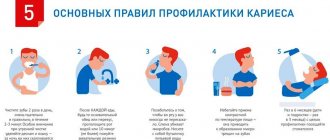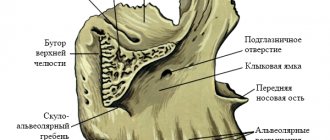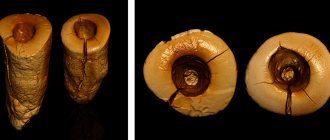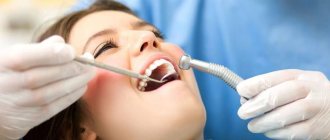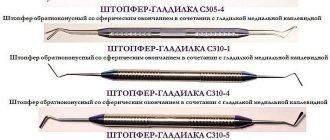Dentists recommend undergoing preventive examinations at least once a year and, if caries is detected, treating it at an early stage. Unfortunately, many patients go to the doctor with an advanced form of the disease. In this article we will tell you why and how deep caries occurs, and we will tell you about treatment methods.
In this article
- Areas affected by caries and stages of the disease
- Deep caries and its features
- Risk factors for deep caries
- Forms of deep caries
- Features of diagnosing deep caries
- How can deep caries be cured?
- Conclusion
Areas affected by caries and stages of the disease
Caries is a dental disease in which, under the influence of microorganisms and other factors, the structure of dental tissues is destroyed.
The mechanism of development of the disease is due to the vital activity of bacteria Streptococcus mutans and some other species. They have a cariogenic effect and create conditions for the development of the carious process. It goes like this. Bacteria accumulate on teeth and form a biological film called plaque. When we eat foods rich in carbohydrates, plaque bacteria actively process the sugars they contain and produce organic acids that are dangerous to our teeth. They destroy the enamel structure, deprive it of minerals, and penetrate deep into the tooth. The more acids produced by oral microorganisms, the more active and rapid the destruction of dental tissue.
Damage to teeth by caries does not occur instantly; it can take several months from a small spot to the appearance of a hole in the tooth. Based on how deeply the carious process penetrates, several stages of the disease are distinguished.
- The earliest is the spot stage.
A small focus of demineralization appears on the surface of the enamel. It looks like a whitish dot or streak. It is almost impossible to notice such changes with the naked eye. And provided that there are no other symptoms (pain or discomfort) at this stage, a person often misses the onset of caries and does not see a doctor.
- Superficial caries.
If the stain was not noticed in time, it gradually grows, the enamel tissue is destroyed, and a cavity is formed in it - a small hole. As a rule, there is still no pain, although food may get into the cavity or tooth sensitivity may increase.
- Average caries.
The form of average caries is characterized by the penetration of the pathological process into dentin - the bone tissue under the enamel. At this stage, a carious cavity forms in the dentin, pain becomes severe, and the tooth reacts to temperature or taste stimuli. Most often, people go to the dentist with the listed symptoms.
- Deep caries.
If for some reason you do not treat average caries, the pathology progresses and approaches the pulp - the dental nerve. This is the most complex and dangerous form of caries, because there is a high risk of infection spreading to the pulp, periodontium and the development of complications.
Our teeth are like stones
Tooth enamel is the outer protective shell of the tooth, which is 97% composed of hydroxyapatite crystals (Fig. 4) - Ca10(PO4)6(OH)2 - and foundation proteins: amelogenins and emellines, on which during the development of enamel (amelogenesis ) and hydroxyapatite crystals are strung [2], [3], [6], [7].
Figure 4. This is what the “closest relative” of our enamel looks like - hydroxyapatite. It’s good for him, because he doesn’t know anything about caries!
"Wikipedia"
Hydroxyapatite, although the hardest part of man, is still very sensitive to acids. Acids “stuck” in dental plaque, especially in the area of fissures (Fig. 5) - folds of enamel - begin to destroy the mineral, leading to demineralization of dental tissue, in other words, to softening. The mineral decomposes, forming calcium salts with other acids [3].
Ca10(PO4)6(OH)2 + acid → 10Ca2++ 6HPO42– + 2H2O
Notably, hydroxyapatite can remain dissolved for up to two hours after ingestion. In addition to carbohydrates, the main role here is played by fruit acids. That is why after eating fruit you feel a feeling of cleanliness of the enamel. Over time, saliva neutralizes the effects of acids due to its buffering properties [2]. The more often high-carbohydrate foods are consumed, the more constant the acidification process in the oral cavity becomes. Thus, tooth decay does not depend on the amount of sugar you take, but on the frequency of its consumption: do not eat a bag of sweets during the day, but eat a large dessert once a day.
Figure 5. Enamel folds - fissures - are the favorite place for the “seeds” of caries. It is here that demineralization processes occur especially actively.
drawing by Anastasia Prokhorova
Deep caries and its features
Deep caries is always an advanced pathological process. It cannot arise instantly, in a few days. As a rule, the deep form of caries develops over many months, sometimes years. In this case, the person does not consult a doctor and does not take measures to treat the carious process.
The main feature and at the same time the danger of deep caries is that it is located in close proximity to the pulp - the neurovascular bundle - and creates a threat of the development of pulpitis and periodontitis. The risk of infection spreading to other organs and tissues, as well as tooth loss, increases.
The following symptoms are characteristic of deep caries:
- Aching pain in the area of the affected tooth, which intensifies from hot, cold or when biting. Acute pain with deep caries can occur when a lot of food debris accumulates in the carious cavity.
- Bad breath. Even regular brushing of teeth in compliance with all the rules does not lead to the disappearance of the odor, since it arises due to decay processes in the affected tooth.
- A large hole in the crown of a tooth is the most obvious sign of deep caries.
Dentists note that often with deep caries the patient has no complaints. But this does not reduce the risk of complications.
Radiation diagnostics of chronic periodontitis
In childhood, chronic and acute periodontitis are localized in the area of the bifurcation of primary molars. The image shows a focus of destruction, which is characterized by fuzzy, uneven contours. Other radiological features include:
- predominance of granulating periodontitis;
- localization of destruction in the area of root bifurcation or around the root;
- pathological root resorption;
- spread of destruction to the follicle of the bud.
If the pathology has spread to the germ of a permanent tooth, usually a premolar, characteristic changes will appear on the x-ray - the end plate of the upper wall of the follicle will disappear, and the germ itself will take a different position or die altogether.
Risk factors for deep caries
Deep tooth decay with caries most often occurs in the presence of the following risk factors:
- Poor oral hygiene.
- Abuse of sweet and carbohydrate foods.
- Lack of calcium, fluorine, phosphorus, vitamin D in the body.
- Chronic pathologies of the gastrointestinal tract.
- Disturbances in the functioning of the endocrine and immune systems.
- Genetic background.
And, of course, one of the main reasons for the development of deep caries is late diagnosis and untimely treatment.
Are dental x-rays harmful?
Quite a lot of patients are concerned about whether it is harmful to take a dental x-ray. There is an opinion that dental x-rays are harmful. Today this is just a myth, fostered by panic fear of radiation sickness. As for the dose of X-ray radiation that a person receives during such an examination, we are talking about 0.002 - 0.003x mSv (millisievert is a unit used to indicate the amount of radiation), and according to SanPiN, up to 1 mSv can be received per year for research purposes , so you can take dental x-rays as often as you like, because the main goal of this research method is to improve the quality of diagnosis and treatment of oral diseases. It should also be taken into account that we naturally receive radiation of about 2-3 mSv per year from the environment, the same amount during a two- to three-hour flight on an airplane.
One should be afraid of mutations or radiation sickness leading to death only when radiation exposure exceeds 1000 mSv. According to the Scientific Committee on the Effects of Atomic Radiation at the UN, even with a single sharp irradiation of 500 mSv, a short-term change in the composition of the blood occurs, while the hematopoietic system is able to fully restore its functions, especially if not all cells of the body were exposed to irradiation.
Previously, only film similar to that used in a camera was used to obtain an X-ray image. It was on this that the photograph was projected. Modern digital technologies make it possible to replace traditional X-ray film with a sensor that converts X-rays into a digital signal. In this case, the emitting apparatus remains the same, only the receiving device changes. But a digital sensor requires a shutter speed five times faster than film, which means the radiation dose is reduced proportionally. It should be clarified that we are talking about only fractions of a second of irradiation: 0.05 - 0.3 s for a digital visiograph or 0.5 - 1.2 s for film. It is easy to calculate how many times a year you can safely take dental x-rays: about 300 - 500 times with a digital device or about 100 with a film one.
Forms of deep caries
Deep caries can occur in two forms - acute and chronic. Each has its own characteristics. Acute deep caries is characterized by rapid development and can affect a large area of the tooth in a short time. Upon superficial examination, the cavity in the tooth appears small. But further diagnostics show that this is deep-stage caries, and it has almost reached the tooth root. It is acute caries that is most often accompanied by a complication in the form of pulpitis. Therefore, when treating it, the dentist has to not only prepare the tooth and put a filling on the dental crown, but also remove the nerve and fill the canals.
Chronic deep caries, unlike acute caries, is a slow, sluggish process. Although most of the tooth with this form is destroyed, the carious cavity is smaller in area than with acute caries. The patient may complain of periodic aching pain, which does not depend on external stimuli and occurs on its own.
Depending on the affected area, deep caries can be divided into cervical, fissure or located on the front incisors.
Based on the speed of development of the pathological process, it is divided into compensated (relatively slow development), subcompensated (with an average speed of development) and decompensated (with a high speed of development). Objectively, any form of deep caries can be cured, but it will require varying amounts of time and effort.
White caries - black caries, time plays against teeth
The enamel is translucent and normally ranges in color from light yellow to grayish-white. The color of dentin and any material underneath the enamel greatly affects the appearance of the tooth. Surprisingly, caries begins in the form of the formation of a barely noticeable white matte spot on the enamel (Fig. 6) [3].
Figure 6. “Dental problems.” Over time, the white spots on the enamel caused by caries darken.
drawing by Anastasia Prokhorova
Further, such a stain darkens from frequent meals: the area of the tooth softens more and more, and in the lucky ones a painless hole is formed - a carious cavity [7]. For some unfortunate people, caries is accompanied by inflammation of the tissues around the tooth, infection, and sometimes even an abscess, which can lead not to the small aesthetic problem of “black spots”, but to the loss of the tooth itself.
Features of diagnosing deep caries
Advanced caries often has the same clinical picture as pulpitis and some other dental diseases. Therefore, before starting treatment, the doctor must conduct a differential diagnosis and understand which pathology to treat.
Deep caries can be distinguished from focal pulpitis by a number of symptoms. With pulpitis, probing the cavity with a dental probe will cause pain only in one area - in the area of the pulp, while with deep caries pain occurs over the entire surface of the tooth.
The probing procedure will also help to distinguish deep caries from medium ones. On average, it is almost painless, because a fairly thick layer of dentin remains between the sensitive pulp and the bottom of the carious cavity. With a deep form, the tooth reacts to probing with severe pain. The method of electroodontodiagnostics helps to distinguish deep caries from fibrous pulpitis. In most cases, the doctor will order an x-ray to confirm the diagnosis.
Radiation diagnostics of pulpitis
If pulpitis is suspected, dentists prescribe this diagnostic method to determine treatment tactics. The study provides information about the condition and length of the root, the degree of its formation, and the condition of the periodontium. Pulpitis of molars in childhood is accompanied in half of the cases by osteoporosis of bone tissue in the area of root bifurcation.
Pulpitis is often confused with periodontitis, which leads to mistaken tooth extraction. This is due to the fact that similar symptoms are present on the x-ray in both cases. However, when treating pulpitis of primary teeth, a compact plate of the follicle wall must be present throughout, while with periodontitis it is not visualized.
Radiation diagnostics makes it possible to determine the degenerative processes in the pulp that have caused the formation of denticles - parietal or free. In the picture they are visible as rounded single or multiple dense shadows against the background of the root canal or tooth cavity. Only an x-ray can determine the cause of pain if it was caused by infringement of the nerve tissue of the pulp by such a denticle.
How can deep caries be cured?
A disease such as deep caries can be treated in one or two visits.
The first option is carried out according to this scheme:
- The doctor numbs the affected tooth with a local anesthetic.
- Opens the carious cavity and, using a drill, cleans it of dead and diseased tissue until dense walls and bottom remain.
- If caries is complicated by pulpitis, endodontic treatment is carried out, that is, the dental canals are filled.
- To treat inflammation, isolate the sensitive pulp from the effects of filling material, and build up dentin, a therapeutic or insulating pad is placed at the bottom of the cavity.
- After all the above manipulations, the tooth is closed with a filling.
Treatment in two visits is carried out according to this scheme.
During the first visit, pain relief is performed, the cavity is opened and the affected tissue is removed. A medical pad is placed in the cavity and closed with a temporary filling. On the second visit after a few days or weeks, if the patient has no complaints, the temporary filling is replaced with a permanent one.
Treatment in two visits is considered preferable because it is possible to observe the condition of the tooth before installing a permanent filling. If pain, discomfort and other symptoms occur, additional therapeutic procedures can be performed to ensure that the affected tissue is completely removed. When treating a tooth in two visits, complications and relapses of caries occur much less frequently.
Radiation diagnostics of dental injuries
After an injury, radiation diagnostics of the damaged and adjacent teeth, and sometimes antagonists, is almost always prescribed. The scope of emergency dental measures depends on its results. The most common injuries are:
- tooth fractures - isolated or combined, that is, in combination with a violation of the integrity of the jaw (the same symptoms are noticeable in the picture as with jaw fractures);
- dislocations - mainly in the area of the incisors (the x-ray shows how the tooth has come out of the socket, and with subluxation, the asymmetry of the periodontal gap is noticeable).
Radiation diagnostics is also used for other dental diseases if the benefits from it outweigh the expected harm from radiation.
Relevance.
The frequency of occurrence of dental caries in the population requires timely diagnostic measures, including objective x-ray examination, the significance of which becomes especially obvious in complex clinical situations.
Purpose of the study
— improving the quality of diagnosis of carious dental cavities by studying the features of their display using different X-ray examination techniques.
Material and methods.
In an experiment on skeletonized jaws with teeth and in clinical studies of patients, 453 intraoral periapical and interproximal radiographs, radiographs performed using a parallel technique, and 432 orthopantomograms were studied. Intraoral X-ray devices Trophy Radiologie (France) and Heliodent DS (Germany), orthopantomographs Proscan (Finland) and Orthophos XG5 DS Ceph (Germany) were used.
Results.
On periapical radiographs, carious cavities on the chewing surfaces of teeth projectedly increased in size vertically and often overlapped the tooth cavity, creating a false picture of perforation. At the same time, in the teeth of the upper jaw, carious lesions were displayed less clearly. On orthopantomograms, radiographs performed using a parallel technique, and especially on interproximal photographs, caries of the chewing surface of the tooth was more clearly visualized. Cavities usually become noticeable when they penetrate the dentin layer. Enamel caries was displayed less clearly, and in case of small lesions it was not detected at all due to the intense shadow of the preserved enamel layer being layered on the carious defect. Enamel defects varied when the enamel layer was affected by ½—¾ or more of its thickness. In all of the listed types of images, the shadows of carious cavities on the vestibular and oral surfaces in the natural fissures of the tooth crowns and in the cervical region, as a rule, were added to the gaps of the tooth cavity. Carious destruction was visualized when it reached a significant size, or when it did not overlap the shadows of the tooth cavity. Lesions of contact surfaces and the cervical part of different groups of teeth were detected on intraoral radiographs and orthopantomograms better than caries of other localizations. However, when the teeth were crowded, the image of the contact surfaces of the tooth crowns was summed up, especially on orthopantomograms. The additional use of intraoral imaging using a parallel technique or interproximal radiography made it possible to answer the question about the absence or presence of hidden carious cavities. It should be noted that during clinical instrumental examination, small carious lesions on the contact surfaces of tooth crowns, especially with close proximity and crowding of teeth, were difficult to access or inaccessible for detection. Cervical carious cavities on the distal surface of the second molars of the lower jaw, which arose at the site of contact of the crown of the dystopic and impacted third molar, were not detected during clinical examination and were clearly visualized on intraoral radiographs performed using a parallel technique, and on orthopantomograms. Small carious cavities under fillings and artificial crowns were not diagnosed on radiographs due to the summation with intense shadows of filling material, metal-ceramic or metal crowns. These cavities were identified only when they reached a size that allowed them to appear behind the contour of the radiopaque material. During periapical photography, the shadows of metal crowns were often combined with carious cavities located below the equator of the crown. These cavities were better visualized on interproximal films and radiographs obtained using a parallel technique. With digital radiography and orthopantomography, the difference in the density of blackening at the border between the intense shadow of a metal crown or filling and the shadow of the tooth created a picture of a decrease in the density of hard dental tissues, simulating carious destruction. A similar situation sometimes arose in the area of the enamel-dentin border due to the unequal X-ray density of the enamel and dentin layers.
Conclusion.
X-ray examination is of critical diagnostic importance in identifying carious lesions on tooth surfaces that are difficult to access for clinical examination. Moreover, in the event of a questionable picture of the presence of caries on an orthopantomogram, it is advisable to additionally use intraoral radiography using a parallel technique or interproximal radiography for clarifying diagnostics.
Prices for treatment of caries of anterior teeth in Moscow
The price for treating caries of anterior teeth largely depends on the technique used. Standard therapy with the installation of a light filling will cost from 5,800 rubles. But prices for restoration start at 12,500 rubles. Treatment costs approximately the same without an Icon drill. Treatment of pulpitis on the front teeth involves cleaning the canals, which will add several thousand more to the total amount. If the tooth is seriously damaged and installing a filling is impossible, get ready for serious expenses. The average cost of a ceramic crown is from 25,000–30,000 rubles, and turnkey implantation will cost at least 55,000–100,000 rubles for the installation of one implant.
Where can I get a dental x-ray and how is it done?
Today, dental photographs can be taken in almost any clinic. As a rule, the best dental clinics in Moscow have equipment that allows you to take dental x-rays directly during the treatment process, without lifting the patient from the chair. These are so-called dental visiographs, the image from which is instantly transmitted to the screen, and the dentist can immediately make a diagnosis or assess the quality of treatment. In order for the most informative photograph of the teeth to be obtained, it is necessary to remove all jewelry. When performing an x-ray, be sure to wear a protective apron and collar. You will have to remain still for some time. As a rule, there is no need to take a photograph of your teeth at another dentistry, especially since many clinics refuse to issue photographs in person under various pretexts. However, according to the Russian law “on personal data”, they do not have the right to do this, and such a position of a dental clinic often negatively affects its reputation.
Publisher: Expert magazine about dentistry Startsmile.ru
Author of the material: Yulia Usacheva
